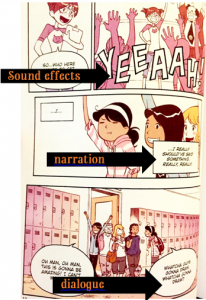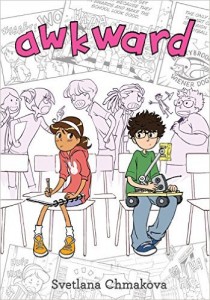** Contact us if you would like to have one of our engaging mentor text sessions come to your campus! **
Sherry and I have been busy bulking up our graphic novel library, as our session on graphic novels has been in high demand. In the process of enhancing our library, I was on the hunt for a strong middle school graphic novel that had depth but would speak to the average student. Based on the cover and book reviews, this seemed to fit that bill.
Why I Finished It:
It was fun. It was like reading a Disney XD show, which admittedly I enjoy watching with my children. Similar to Disney shows, each character in the story was well developed with very specific personality traits. The plot, while simple for the targeted age, leaves a lot to be discussed. The main character, Peppi is dealing with typical teenage issues, such as not feeling like she belongs, feeling jealous of other kids, regretting decisions, etc. Other characters are dealing with harsh family dynamics, low self-esteem, and finding their place in school and life. I love that the plot was fast paced and the average middle school student would find some part of it with which to identify. It was hard to put the book down because the lives of the characters and plot were so fluid and engaging.
Who I Would Give It To:
Our students love the Disney middle-grade sitcoms and they will love this book. This book is great for any student in this age range, boy or girl, popular or not, it’s just a solid middle-grade book.
Integration Ideas:
Reading Graphic Novels
There is so much to reading a graphic novel. (Sherry and I have a conference session and half day session dedicated to helping teachers really understand the complexities of teaching graphic novels effectively!)
Before reading the book, explain how a graphic novel is laid out. It is important for students to see how the book is sequenced and in what order it should be read. Have a few pages projected for the class and model the direction of reading. Other parts to model:
- Speech bubbles are for dialogue
- Thought bubbles are for inner thinking
- Text boxes are for narration
- Font changes and sizes matter, find the deeper purpose.
- Sound effects and any extras in the book you’re reading
It’s important for students to realize that “graphic novel” is more of a medium (as opposed to a genre), and as such, there are certain skills and strategies for comprehension that they must learn. For example, they must read both the text and the pictures to get the full story.
Theme
There are a few themes here, as with all books. Some possibilities, with guiding questions, are:
- Treat others the way you want to be treated
- Why is it important to respect people for who they are?
- If you are disrespected, how should you react?
- Friendship
- How do you know if your relationships are helpful or hurtful?
- What makes a good friend?
- How do people become friends?
- What can cause friendships to change?
- Integrity
- Should the right thing always be done, even if it will have a bad effect for some?
- Is it important to always tell the truth?
- Is it important for everyone to have the same values and beliefs?
Making Inferences, Predicting, and Characterization
I have always felt that learning to make inferences with pictures and/or comics is a great way to teach students this complex skill. In graphic novels, part of the story is told with the illustrations. The characters are showing their emotion through the way they act and interact with other characters. In a novel, inferences about characters rely solely to the words the author provides. In a graphic novel, the reader must also pay attention to the character traits portrayed through the pictures. Students have to slow down and study the expressions of characters and how they are interacting with other characters. On key pages, cover up the dialogue of the characters, and have students just study the pictures. Have students make inferences about what is happening on the page. Students must supply text evidence (pictures) and their background knowledge to infer how the character is feeling. Once this is complete, they can read the words to see if they need to adjust or add to their character inferences. Students should also make predictions for what the character will do or how the character will change and grow throughout the text. Click here for more information on making inferences with comics.
Author’s Website – http://svetlania.com/







Leave a Reply